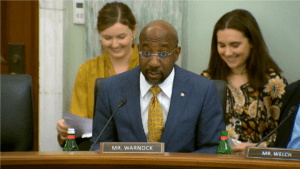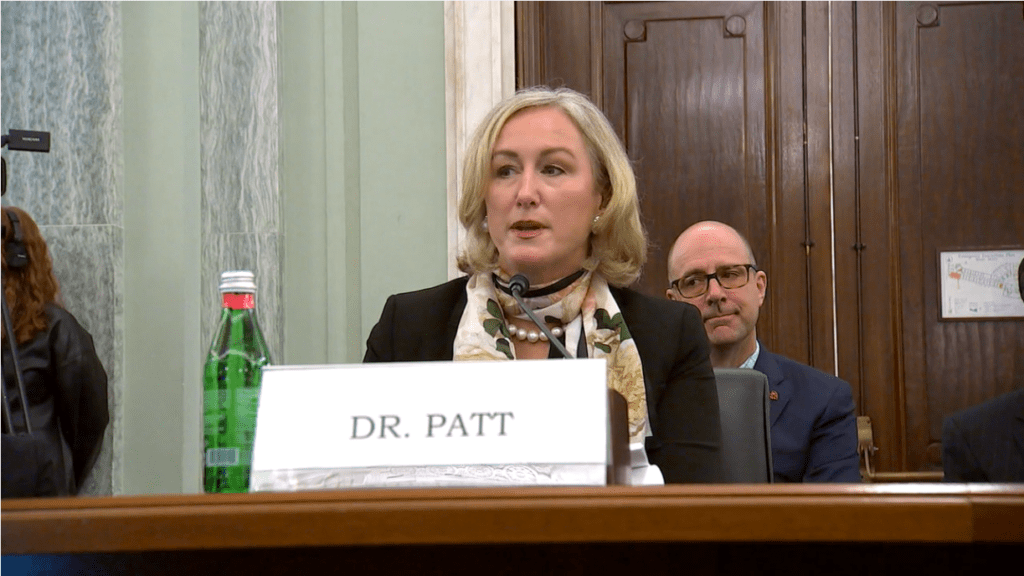How can it be that for more than 10 years now the United States has increased imports of generic drugs from India and China, yet prices of many of these key, basic drugs, like insulin, continue to rise? No one will give you a failing grade for not knowing what pharmacy benefit managers (PBM) are – the middlemen that really dictate drug pricing in America. But the Senate took that entire healthcare sub-sector to task in a Commerce Committee hearing on Feb. 16 titled “Bringing Transparency and Accountability to Pharmacy Benefit Managers.”
“If given the choice, would you eliminate PBMs?” asked Sen. Marsha Blackburn (R-TN).
“They should be regulated the same way the rest of us are as healthcare providers. They’re part of the healthcare system,” said one of the four witnesses, Ryan Oftebro, CEO of Seattle-based independent pharmacy Kelley-Ross Pharmacy Group.
CPA released a report in 2021 that highlighted how pharmacy benefit managers contribute to the surge of low quality generic drug imports. In their race to maximize profit, PBMs procure from nations like India and China where costs are low and where manufacturers have a history of receiving warning letters from the FDA for violations of current good manufacturing practices. As the Senators noted in the hearing, PBMs rarely pass on any cost savings to patients.
What is a PBM? Insurance companies hire a pharmacy benefit manager, or PBM, to manage the drug portion of their health insurance policy. The PBM manages a formulary, or a list of insurance policy covered medicines, which gives the PBM leverage to negotiate lower prices with big drug companies. But gauging by the temperature in the Senate this week, that’s not what is happening.
“It’s tempting to say that I would completely eliminate PMBs…but the truth is I don’t know if that is the right answer. But I do think it would make things better currently,” said Debra Patt, a cancer specialist at Texas Oncology. “We’ve seen no evidence that their supposed discounts are transferred to patients in the form of lower drug costs.”
The Schaeffer Center for Health Policy at the University of Southern California did a study that found that for every dollar Americans spend on insulin, less than half went to the manufacturer and the bulk of it really went to the middlemen, the PBMs.
According to the Wall Street Journal, “PBMs and health plans are expected to prefer the more expensive version to get higher rebates.”

“Zero. Zilch. Nada,” says Sen. Jon Tester (D-MT) when talking about the impact pharmacy benefit manager groups have on lowering prescription drug costs, as they were intended.
“If you wonder whether you heard that correctly, PBMs are blocking a cheaper product,” said Sen. Chuck Grassley (R-IA).
In 2018, Grassley asked the Federal Trade Commission (FTC) to assess consolidation in the pharmaceutical supply chain and its impact on drug prices. It took until last year for the FTC to take action and even start studying PBMs. Grassley’s Prescription Price for the Peoples Act, introduced in the Senate in April 2021, would require the FTC to study these pharmaceutical intermediaries and issue a report and recommendations to Congress within one year. That bill has languished in the Senate since.
Oftebro gave one example of price manipulation of the generic drug rosuvastatin, an inexpensive drug used to lower cholesterol. “Historically, a 90-day supply of rosuvastatin costs the pharmacy approximately $10. Insurance co-pays were set by the PBM at $15 for a 90-day supply. But things changed in 2021, with patients’ costs increasing exponentially. The PBM moved rosuvastatin from their Tier 1, with a nominal co-pay, to their Tier 3, which historically has been reserved for brand name medications only. This increased the patient co-pay, which was set by the PBM, from $15 to $141 for the same 90-day supply. There’s no clinical rationale for this change and there was no increase in drug costs.”
Astra Zeneca, a European-based pharmaceutical giant, makes rosuvastatin under the brand name Crestor. This drug is contract manufactured worldwide and exported to the U.S. China pharmaceutical companies are huge exporters of this drug, suggesting the price baseline is already low.
Patt gave the Senate Committee an example of a patient taking the cancer drug imatinib – also sold under the brand names Gleevec and Glivec and marketed worldwide by European pharma giant Novartis at contract manufacturing organizations worldwide.
“If the patient had run it through their insurance, their co-pay would have been $1,500 per month. And whenever they didn’t go through insurance, it was going to be just $150 a month at our practice,” Patt said. “If a doctor and pharmacist don’t have the ability to work together, then the patient would have just not taken the medication due to cost. We know from a study published in the Journal of Clinical Oncology in 2017 that patient adherence to their medication is directly related to their co-pay,” she said, in which PBMs play an outsized role.
Cancer drugs have attracted PBMs of late. The three largest pharmacy benefit managers control 80% of the prescription drug market. The next three largest add up to 96% market control.
A Schaeffer Center study mentioned in the hearing found that while total expenditures per unit of insulin remained relatively stable from 2014 to 2018, manufacturers of that generic drug were actually getting paid less year over year. Meanwhile, the share of spending captured by PBMs increased 155% over that same five-year period.
“At this point, less than half of each dollar spent on insulin goes to the manufacturers. Instead, the majority gets siphoned away by intermediaries. A parasitic loss, if you will,” said Erin Trish, Co-Director and Associate Professor of Pharmaceutical and Health Economics at the University of Southern California.
 Sen. Raphael Warnock (D-GA) said that the “larger root cause” of high prescription drug prices were issues surrounding PBMs. “It is no secret that pharmacy benefit managers have played a role in high drug prices. How do they do that?”
Sen. Raphael Warnock (D-GA) said that the “larger root cause” of high prescription drug prices were issues surrounding PBMs. “It is no secret that pharmacy benefit managers have played a role in high drug prices. How do they do that?”
Trish responded that PBMs were in a position where they make more money as the list price of the drug goes up because they get a percentage of the rebate or some other type of fee that’s based on that increasing list price.
“And so, you’ve seen, even though a drug like insulin is a very highly competitive drug class, there’s multiple products that exist there, and the rebates are enormous, typically more than half of the list price. But nonetheless, the pressures and the incentives have made it so that if one manufacture has opted to offer a lower price, PBMs simply won’t put them on their formularies,” Trish said.
Committee Chairwoman Maria Cantwell (D-WA) introduced legislation in May 2022 called the Pharmacy Benefit Manager Transparency Act but that is stuck in the committee in which she chairs.
The hearing centered on PBMs and how to change the rules of the game in an attempt to keep drug prices low. Often times people believe that drugs made in the U.S. would be naturally more expensive than those made in countries like India. But that is not the case. The main reason for higher generic drug prices lies with the PBM.
At the end of the hearing, Sen. Amy Klobuchar (D-MN) brought up drug shortages. And how the U.S. turns to other countries when we have a shortage. “What are PBMs and drug manufacturing doing to better anticipate and forecast demand for medicines and avoid shortages?” she asked.
The 2021 CPA report outlines how reliance on foreign manufacturers, particularly those in China and India where manufacturing quality and oversight standards are poor, has proven to be a major factor in causing shortages, offshoring of U.S. production, and encouraging price gouging and lackluster transparency.
From that CPA report: “This race to the bottom has been exacerbated by the role of middlemen in the pharmaceutical industry. Group Purchasing Organizations (GPOs) and Pharmacy Benefit Managers (PBMs) — also known as middlemen — all have the common goal of maximizing margins and short-term profit. While the GPOs and PBMs’ efforts to maximize return at the expense of any other considerations have created their own set of quality control and safety issues, their efforts to secure the lowest possible price point for drugs have also provided implicit support for overseas manufacturers that can cut corners on environmental and worker standards to manufacture drugs below the market rate.” — Generic Drug Shortages and How a Race to the Bottom in Price has Upended 30 years of Hatch-Waxman, Coalition for a Prosperous America, October 20, 2021.
“I got to be honest with you. The way I see the situation on PBMs, I don’t even know why they exist,” said Sen. Jon Tester (D-MT). “They were set up to negotiate drug prices. But I don’t see them lowering prices. I dont see us holding big pharmaceutical companies accountable. And there is zero transparency in this (PBM) business. The only guys who win in healthcare costs, are the PBMs.”
Pharmaceutical imports are the No. 1 manufactured good imported into the U.S. Most of it comes from Europe, India and China.
India and China are increasingly the leading source for generic drugs, which account for 90% of all prescriptions written in the U.S. In 2021, China was the leading source for U.S. pharmaceutical imports measured by weight, accounting for 190 million kilograms (418 million lbs) or 23% of total pharma imports. Growing U.S. dependence on China and India for widely-used generic pharmaceuticals creates serious supply chain risk and patient risk as the FDA does not have easy access to labs there. China now accounts for 95%of imports of ibuprofen, 91% of imports of hydrocortisone, 70% imports of acetaminophen, and 40 to 45% of imports of penicillin, according to a new study by CPA senior economist Andrew Heritage, published in January.













